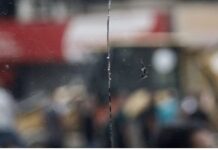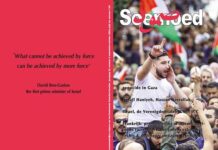Razmig Bedirian
The National / August 30, 2024
Director Goran Hugo Olsson uses 30 years of STV archive footage to show how the framing of journalistic coverage shaped public opinion on the conflict.
At this year’s Venice Film Festival, Swedish filmmaker Goran Hugo Olsson is braced to deliver one of the festival’s most intriguing projects – Israel Palestine on Swedish TV 1958-1989, a documentary made entirely of archival material that once shaped the way the Swedish public understood the conflict.
Olsson was four years into the project when the war in Gaza began. For him, it became an urgent task to share his work with the world when he saw footage of the conflict. As the devastation grew, the filmmaker was compelled to complete a project that had the potential to serve the public good, he tells The National.
“It replayed in another dimension,” the Swedish director says of the videos that began emerging out of Gaza. War-trodden landscapes, survivors being pulled out of shelled homes, bodies draped in white and blood-curdling expressions of grief. Olsson had been going through 5,000 hours of archival material on this conflict, and now it was playing in real-time and with ever-increasing horror.
“It’s not me [that’s going through this]. I am not a victim,” he says. “But as a human being, this has been a total nightmare. I can’t talk about it without being in despair about humanity and the victims of this last year.”
As such, Israel Palestine on Swedish TV 1958-1989 has been the most painful project Olsson has taken on. “I think for the rest of the world, there was a greater demand and interest in the film, but for me, it was just sadness and a horror,” Olsson says. “The only thing I wanted in relation to the film and the events during and after October 7 was to get it to the audience as quickly as possible.”
The documentary compiles footage that begins in the decade following the Nakba and the occupation by Israel. It concludes around the end of the Cold War, highlighting its implications for Palestine. The decades in between feature interviews with Palestinian refugees, resistance fighters and leaders, including Bassam Abu Sharif and Yasser Arafat, as well as with Israeli figures, such as David Ben-Gurion and Abba Eban. It explores the geopolitical repercussions of the 1967 and 1973 wars, while also highlighting global implications.
The idea for the documentary found form as Olsson gained access to the archives of the Swedish national public television broadcaster, Sveriges Television AB (SVT). He had been working on another project at the time, but as he came across a trove of footage about Israel and Palestine, he noticed there was something unique about the coverage.
“We discovered this material, and what we saw was some kind of narrative, some kind of story about the narrative and how it developed from 1958 until the Oslo [Accords],” he says.
For decades, SVT held a monopoly on public-service television broadcasting in Sweden. Its coverage had an unparalleled effect in moulding public opinion on global affairs. The company aimed to provide objective reporting – and yet, considering its coverage in the 1950s, it is evident that this was not the case.
Up until the 1967 Arab-Israeli war, SVT made no explicit mention of Palestine or Palestinian people, instead referring to them as Arabs or Bedouins. Israel, on the other hand, was presented as a “land of wonders”, Olsson says.
“The first 10 years in Sweden, it was all about how [the Israelis] cultivated the desert; they brought people from all over the world; they created a new language,” he says. “They also used colonize as a positive word. They ‘colonized’ the desert. That was a positive thing. That’s how they saw it at that time.”
SVT soon had to reckon with this one-sided and hyperbolic depiction, as the 1967 war led to a refugee crisis. Israel had emerged victorious in the conflict, taking control of Gaza, the Sinai Peninsula, the West Bank and Jerusalem. Many Palestinians were forced, again, to flee their homes.
It became clear that there were people there before Israel, Olsson says. He adds that SVT then began featuring the refugees and the resistance movement as part of their coverage.
SVT, Olsson points out, had three teams stationed in the Middle East. “That’s a lot for a country like Sweden at that time,” he says. “This is the peak of the Cold War. So Sweden was neutral and could have access to all sides.”
The footage featured in Israel Palestine on Swedish TV 1958-1989 has no additional commentary. There are title cards that reveal when the footage was originally broadcast, and the team behind the work, but Olsson says he was mindful not to impose his own narrative upon the film.
“We wanted to make a representation of what was broadcasted and how it was broadcasted, and keeping the [original] feeling,” he says. There are certain sequences that have been put together from many different sources, such as a montage exploring the 1967 war, but those are clearly marked as such. A large part of the documentary aims to preserve the original broadcasts as they were originally aired, with some “creative editing” for the sake of brevity and focus.
“I think this is a contemporary way of doing documentaries,” Olsson says. “When you see a documentary in this kind of cinematic environment, you want to be treated with respect. Most people watching a film like this are on Wikipedia at the same time, so I don’t have to write, for example, when Yasser Arafat died.
“That’s not the film’s duty. I want you to get the feel that you are actually seeing the raw footage, in a way, and make up your own mind.”
Olsson says when he began the project, he wanted to explore the development of a narrative across time while exploring an era when SVT had the monopoly of public broadcasting in Sweden. However, as the war in Gaza began, Olsson’s motivations changed, even if his technical approach to making the film was unaffected.
“Since October 7, I want the film to be a reminder of the idea of peace; to be able to talk about co-existence and understanding,” he says. “It’s not just in the Middle East. Everything is harder with more violence and weapons. We have to subscribe to the idea that justice comes first, but you have to have a goal. And the goal of justice is peace.”
Razmig Bedirian is The National’s Arts & Culture editor












